
A flat-twin engine is a two-cylinder internal combustion engine with the cylinders on opposite sides of the crankshaft. The most common type of flat-twin engine is the boxer-twin engine, where both pistons move inwards and outwards at the same time.
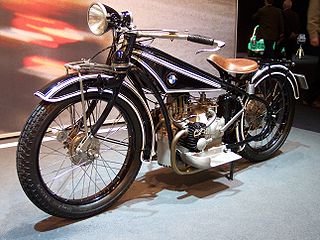
BMW's motorcycle history began in 1921 when the company commenced manufacturing engines for other companies. BMW's own motorcycles—sold under the BMW Motorrad brand—began in 1923 with the BMW R 32, which was powered by a flat-twin engine. Production of motorcycles with flat-twin engines continues to this day, however BMW has also produced many models with other types of engines.
Franz Josef Popp was one of three men responsible for the founding of BMW AG and the First General Director of BMW AG from 1922 to 1942.

Sunbeam Cycles made by John Marston Limited of Wolverhampton was a British brand of bicycles and, from 1912 to 1956 motorcycles.

The Kawasaki Concours, known as the GTR1000 in some markets, is a 1,000 cc sport touring motorcycle manufactured between 1986 and 2006 by Kawasaki. In 2007 it was replaced by the larger displacement Concours 14, also known as the 1400GTR.
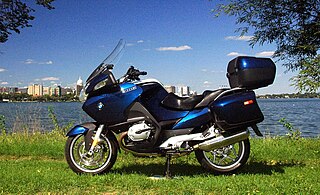
The BMW R1200RT is a touring or sport touring motorcycle that was manufactured from 2005 to 2019 by BMW Motorrad to replace the R1150RT model. It features a 1,170 cc (71 cu in) flat-twin engine with a six-speed gearbox and shaft drive.

Douglas was a British motorcycle manufacturer from 1907–1957 based in Kingswood, Bristol, owned by the Douglas family, and especially known for its horizontally opposed twin cylinder engined bikes and as manufacturers of speedway machines. The company also built a range of cars between 1913 and 1922.
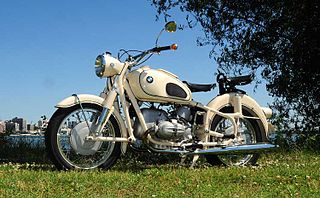
The R69S, R69US, and R69 are motorcycles, fitted with 594 cc boxer twin engines, that were manufactured by BMW in Munich, Germany.

For the WWII-era motorcycle, see BMW R75

The BMW R68 is a 594 cc (36.2 cu in) sport version of the pre-1955 BMW motorcycles. A total of 1,452 models were manufactured from 1952 to 1954, making it one of BMW's rarest production motorcycles.
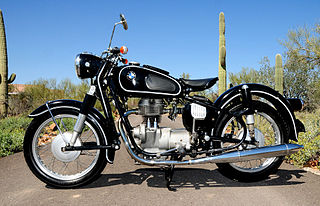
The 247 cc BMW R27, introduced in 1960, is a shaft-driven, single-cylinder motorcycle manufactured by BMW.
Max Friz was a German mechanical engineer specializing in engine design. He was the key contributor of engine design and innovation that led to the founding of Bayerische Motoren Werke AG (BMW) in 1917.

The official founding date of the German motor vehicle manufacturer BMW is 7 March 1916, when an aircraft producer called Bayerische Flugzeugwerke was established. This company was renamed to Bayerische Motoren Werke (BMW) in 1922. However, the BMW name dates back to 1917, when Rapp Motorenwerke changed its name to Bayerische Motoren Werke. BMW's first product was a straight-six aircraft engine called the BMW IIIa. Following the end of World War I, BMW remained in business by producing motorcycle engines, farm equipment, household items and railway brakes. The company produced its first motorcycle, the BMW R32, in 1923.

Rapp Motorenwerke GmbH was a German aircraft engine manufacturer based in Munich, Bavaria. Founded in 1913, the firm changed its name in 1917 to Bayerische Motoren Werke GmbH (BMW). The company later became known as Süddeutsche Bremsen-AG after its engine-production assets and the BMW name were transferred in 1922 to Bayerische Flugzeugwerke, which was then renamed to Bayerische Motoren Werke AG and subsequently evolved into the automotive manufacturer known today as BMW.

The BMW M2B15 was BMW's first flat-twin engine. Manufactured from 1920 to 1923, the M2B15 was intended to be a portable industrial engine, but it was used by several German motorcycle manufacturers to power their motorcycles.

The BMW R 80 G/S is a motorcycle that was manufactured in Berlin, Germany, by BMW Motorrad from 1980 to 1987. Production totalled 21,864 bikes. It was the first in the BMW GS family of specialised dual-sport bikes, of which over 500,000 have been produced, and is often considered the world's first "Adventure Bike" able to be equally as capable both on and off-road. The designation G/S stands for the German words Gelände/Straße, which mean offroad/road – highlighting the bike's dual sport design.
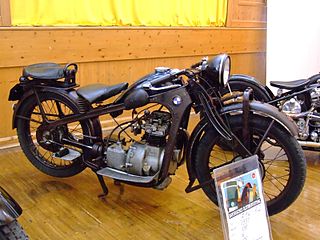
The BMW R2 was a 198 cc overhead valve single-cylinder motorcycle produced by BMW between 1931 and 1936, the smallest motorcycle ever to enter series production with the firm. Despite its much smaller design and engine capacity, the R2 retained many features of the larger boxer twin motorcycles in the range, such as cardan shaft drive and a pressed-steel duplex frame. The R2 was the smallest in the range of singles produced during the 1930s by BMW, with its big brothers being the 305 cc R3 and the 400 cc R4.
Ulsan Industrial Center Monument, widely known as Gongeoptap, is a monumental tower located in Gongeoptap Rotary, Namgu, Ulsan.

The BMW R12 and R17 are flat-twin engine motorcycles made by BMW Motorrad from 1935 through 1942. They were developed in 1935 based on the R7 concept of 1934. A few hundred R17s were made, ending in 1937, while the R12 continued through 1942, with a total of 36,008 produced.

The G450X is an Enduro-class motorcycle that was produced by BMW Motorrad between 2008 and 2011.
Ref: Any picture of the bike shows the trailing links.


















